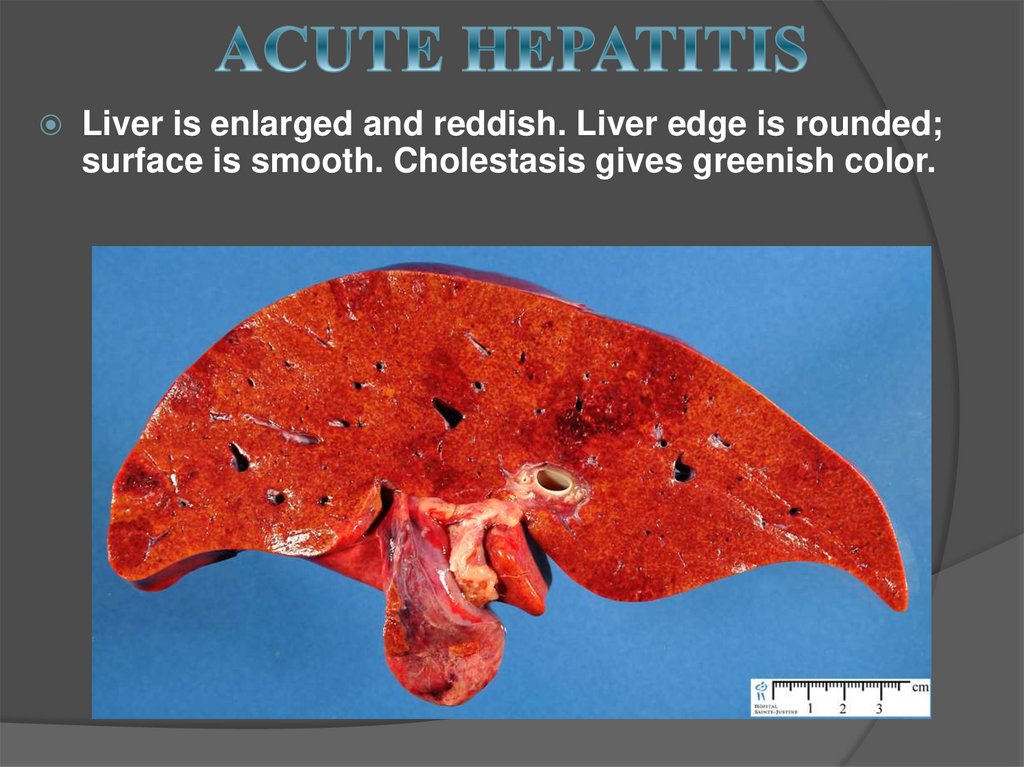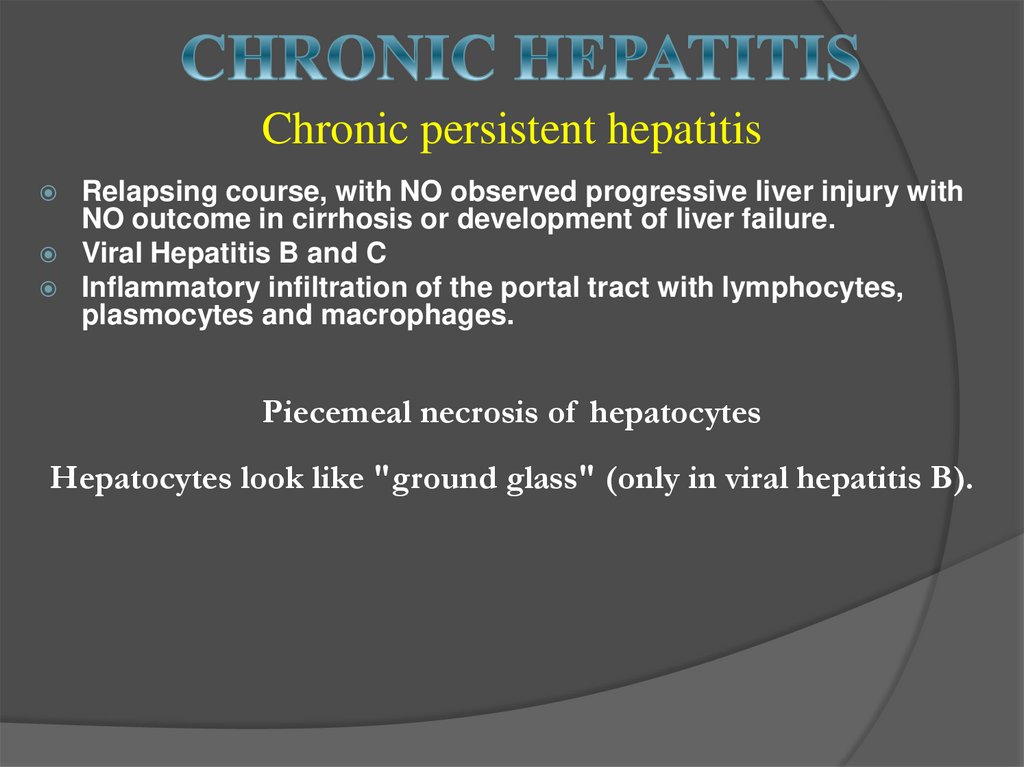Похожие презентации:
Liver diseases
1. LIVER DISEASES
International Medical FacultyPathological Anatomy Department
Lecturer - Kriventsov M.A.
2.
Classification of liver diseases, their ethiology andpathogenesis
Hepatoses: definition, ethiology, pathogenesis,
pathological anatomy, complications and outcomes
Hepatitis: definition, ethiology, pathogenesis,
pathological anatomy, complications and outcomes
Liver cirrosis : definition, ethiology, pathogenesis,
pathological anatomy, complications and outcomes
Causes of death
3.
4.
1. Hepatocytes changes2. Activation of sinusoid
cells
5.
3. Disse space(staining
van Gison)
4. Inflammatory infiltration
of portal tracts
(possible formation of
lymphoid follicles)
6.
5. Immune damage ofhepatocytes
7.
6. Changes in bile ducts8. CLASSIFICATION OF LIVER DISEASES
Congenital abnormaliesHepatoses (lipid, pigment, etc.)
Hepatitis (alcoholic, viral, etc.)
Liver cirrhosis
Hepatic tumors
9. HEPATOSES
Hepatosis is a disease of the liver withdystrophy and necrosis of hepatocytes
1. Poisoning (phosphorus, arsenic, alcohol, drugs,
mushrooms, food)
2. Hepatitis
3. Sepsis
4. Hereditary metabolic disorders
5. Hypoxia in cardio-pulmonary pathology
Nonalcoholic fatty liver disease
Alcoholic liver disease
Other toxic liver diseases
IDC10
10. HEPATOSES
STAGE OF YELLOW DYSTROPHYMacroscopic: liver is enlarged, compact or loose,
bright yellow color. Then it decreases, becomes
flabby with wrinkled capsule; liver tissue section is
gray to yellow.
Microscopic: fatty degeneration of hepatocytes in
centers of lobules, quickly changing into necrosis
and formation of fat and protein detritus.
11.
12.
13. HEPATOSES
STAGE OF RED DYSTROPHYLiver continues to decrease and becomes red. Necrosis in
all parts of the lobule; only at the periphery is a narrow
strip of hepatocytes in a state of fatty degeneration.
14. HEPATOSES
FATTY LIVER (STEATOSIS)Fatty dystrophy of hepatocytes
- powdered
- small drops
- large drops
15. HEPATOSES
Mallory Bodies16. HEPATITIS
Hepatitis is a common name for acute orchronic diffuse inflammatory diseases of the
liver with various ethiology.
Acute
Chronic
• Agressive (active)
• Persistent
Viral
Toxic (drug, alcohol)
Autoimmune
Parasitic
Bacterial
17. HEPATITIS
VirusCourse
Way to be infected
Chronic
Hepatitis A RNA
Fecal-oral
-
Hepatitis B DNA
Parenteral, perinatal, sexual
+
Hepatitis C RNA
Parenteral, sexual
Hepatitis D RNA
Parenteral (superinfection)
Hepatitis E RNA
Fecal-oral
+
+
-
Hepatitis F RNA
Parenteral
Hepatitis
G
Parenteral
RNA
?
18. HEPATITIS
VirusCourse
Way to be infected
Chronic
Hepatitis A RNA
Fecal-oral
-
Hepatitis B DNA
Parenteral, perinatal, sexual
+
Hepatitis C RNA
Parenteral, sexual
Hepatitis D RNA
Parenteral (superinfection)
Hepatitis E RNA
Fecal-oral
+
+
-
Hepatitis F RNA
Parenteral
Hepatitis
G
Parenteral
RNA
+ Herpes simplex virus, yellow fever virus, cytomegalovirus, measles virus, etc.
?
19.
PATHOGENESISDamage of the hepatic cells by hepatotropic viruses is
based on two possible mechanisms:
Direct cytopathic effect of viruses;
Induction of the immune response againts viral
antigens or antigens of virus-infected hepatocytes
20.
There are several forms due to course and clinical symptoms:1. Carrier state (subclinical course) – except А and Е.
2. Acute hepatitis:
a) Non-icterus form;
b) Icterus form;
c) Fulminant form;
3. Chronic hepatitis:
a) Chronic persistent hepatitis;
b) Chronic active hepatitis.
21.
There are 4 stages in course of the acute hepatitis:Incubation period;
Pre-jaundice;
Jaundice;
Recovery.
Hepatitis A and E have a short incubation period
(several weeks), and hepatitis B and C - the longer one
(up to several months).
22.
Liver is enlarged and reddish. Liver edge is rounded;surface is smooth. Cholestasis gives greenish color.
23.
Diffuse damage of hepatocytes;Focal necrosis of groups or separate hepatocytes;
Reaction of the Kupffer cells and inflammatory
reaction;
Regeneration of cells in recovery stage.
24.
Necrosis of hepatocytes- Rapture of the cell membrane with cytolysis (cell
«disappears»);
- Coagulation necrosis with lysis of nucleus and
formation of acidophylic bodies (Kaunsilmen's
bodies).
+ piecemeal necrosis
+ bridging necrosis
25.
26.
27. Chronic persistent hepatitis
Relapsing course, with NO observed progressive liver injury withNO outcome in cirrhosis or development of liver failure.
Viral Hepatitis B and C
Inflammatory infiltration of the portal tract with lymphocytes,
plasmocytes and macrophages.
Piecemeal necrosis of hepatocytes
Hepatocytes look like "ground glass" (only in viral hepatitis B).
28.
Inflammatory infiltration of theportal tract
"Ground glass" hepatocytes
29. Chronic active hepatitis
Chronic active hepatitis is characterized by progressivedestruction of hepatocytes and development of cirrhosis.
Viral Hepatitis B – 20-30 % of patients;
Viral Hepatitis C – 70-80 % of patients.
+ autoimmune hepatitis.
30. Chronic active hepatitis
Poratal and periportal infiltration with lymphocytes,plasmocytes and macrophages;
Active destruction of hepatocytes in zone between
inflammatory infiltration and surrounding hepatocytes
(piecemeal necrosis);
Destruction of hepatocytes with formation of bridge
between portal tract and central vein (bridging
necrosis);
Progressive substitution of the necrosis foci by the
fibrous tissue with cirrhosis development.
31.
Capillarization of sinusoids - hypoxic damageof hepatocytes
Periportal fibrosis - hypoxic
damage of hepatocytes
32.
33.
1.2.
3.
4.
Liver cirrhosis is characterized by the
following sings:
Dystrophy anв necrosis of hepatocytes
Fibrosis;
Compensatory hyperplasia of hepatocytes
with formation of regenerates nodes;
Deformation of the liver.
34. CLASSIFICATION
Morphological :Micronodular liver cirrhosis
Macronodular liver cirrhosis
Mixed liver cirrhosis
35.
Ethiological:1. Acquired forms
Toxic cirrhosis (such as alcoholic)
Postinfectious
Circulatory
Cryptogenic cirrhosis
Biliary cirrhosis (primary, secondary)
2. Congenital forms:
cirrhosis in hemochromatosis, thalassemia, Wilson's
disease, a-1-antitrypsin deficiency, galactosemia, etc.
36.
Pathogenetic:Portal
Postnecrotic
Biliary
Mixed
37. COMPLICATIONS
1. Liver failure (acute or chronic, up tohepatic coma)
Hepatic encephalopathy
Jaundice
Renal failure
Ascites and edema
Endocrine disorders
Circulatory disorders
Secondary infections
38.
2. Portal hypertensionVaricose changes in portocaval
extrahepatic anastomoses
Ascites
Splenomegaly
3. Cancer of the liver










































 Медицина
Медицина








